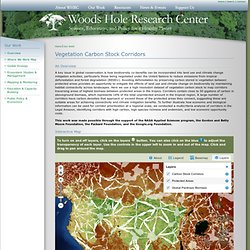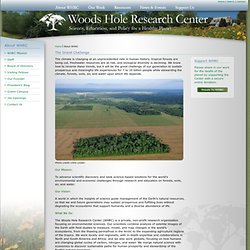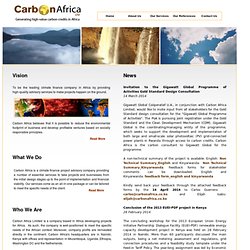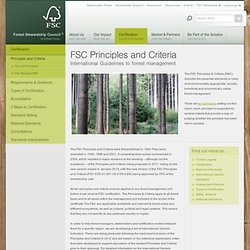

Climate Change. Protected Carbon Stock Corridors. A key issue in global conservation is how biodiversity co-benefits can be incorporated into land use and climate change mitigation activities, particularly those being negotiated under the United Nations to reduce emissions from tropical deforestation and forest degradation (REDD+).

Avoiding deforestation by preserving carbon stored in vegetation between protected areas provides an opportunity to mitigate the effects of land use and climate change on biodiversity by maintaining habitat connectivity across landscapes. Here we use a high resolution dataset of vegetation carbon stock to map corridors traversing areas of highest biomass between protected areas in the tropics. Corridors contain close to 50 gigatons of carbon in aboveground biomass, which represents 14% of the total unprotected amount in the tropical region.
Interactive Map Figures Multicriteria scoring of corridors in the Brazilian Amazon across three dimensions: VCS density, mammalian biodiversity and deforestation threat. EcoPole - The enviromentally-friendly pole. Simba Capital Ltd- Index. Woods Hole Research Center. The climate is changing at an unprecedented rate in human history, tropical forests are being cut, freshwater resources are at risk, and biological diversity is declining.

We know how to reverse these trends, but it will be the great challenge of our generation to sustain prosperous and meaningful life experiences for 7 to 10 billion people while stewarding the climate, forests, soils, air, and water upon which life depends. Photo credit Chris Linder. Our Mission: To advance scientific discovery and seek science-based solutions for the world’s environmental and economic challenges through research and education on forests, soils, air, and water. Our Vision: A world in which the insights of science guide management of the Earth’s natural resources, so that we and future generations may sustain prosperous and fulfilling lives without degrading the ecosystems that support humanity and a diverse abundance of life.
What We Do:
Africa Research Institute. World Agroforestry Centre. Japan announces development of the new Joint Crediting Mechanism. JCM will allow for increased adoption of mitigation actions & facilitate NAMAs, build MRV capacity, diffuse climate finance The Government of Japan initiated the Joint Crediting Mechanism (JCM) in collaboration with partner countries.

The mechanism aims to facilitate the diffusion of advanced low carbon technologies, products, systems, services and infrastructures, which advances mitigation action in developing countries. The JCM is designed and being implemented in a manner by which it can ensure robust methodologies, transparency and environmental integrity; avoid double-counting with regard to GHG emission reductions or removals; and be maintained as a simple and practical mechanism based on its rules and guidelines. For these purposes, the Joint Committee (JC) consisting of representatives from Japan and its partner countries plays an important role. Virgin Green Fund. Home. Invitation to the Gigawatt Global Programme of Activities Gold Standard Design Consultation 14 March 2014 Gigawatt Global Coöperatief U.A., in conjunction with Carbon Africa Limited, would like to invite input from all stakeholders for the Gold Standard design consultation for the "Gigawatt Global Programme of Activities".

The PoA is pursuing joint registration under the Gold Standard and the Clean Development Mechanism (CDM). Gigawatt Global is the coordinating/managing entity of the programme, which seeks to support the development and implementation of both large and small-scale solar photovoltaic (PV) grid-connected power plants in Rwanda through access to carbon credits. Carbon Africa is the carbon consultant to Gigawatt Global for the programme. A non-technical summary of the project is available: English: Non Technical Summary_English and Kinyarwanda: Non Technical Summary_Kinyarwanda.
Forest Stewardship Council ® · Principles and Criteria. The FSC Principles and Criteria were first published in 1994.They were amended in 1996, 1999 and 2001.

A comprehensive review commenced in 2009, which resulted in major revisions to the wording – although not the substance – of the Principles and Criteria being proposed in 2011. Voting on the new version closed in January 2012, with the new version of the FSC Principles and Criteria (FSC-STD-01-001 V5-0 D5-0 EN) being approved by 75% of the membership vote. All ten principles and criteria must be applied in any forest management unit before it can receive FSC certification. The Principles & Criteria apply to all forest types and to all areas within the management unit included in the scope of the certificate.The P&C are applicable worldwide and relevant to forest areas and different ecosystems, as well as cultural, political and legal systems.
This means that they are not specific to any particular country or region. Rift Valley Institute. The Largest Online Community of Investors, Angels and Entrepreneurs Dedicated to Building Businesses in Africa. How We Made It In Africa – Insight into business in Africa.